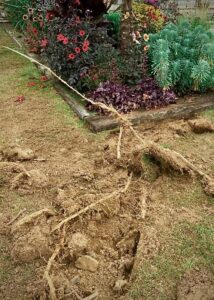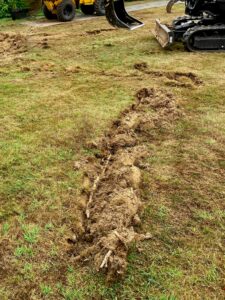The role root barriers play in amenity areas
Related Articles
Trees provide the serene backdrop to the most spectacular or humblest of golf courses. They are also the focus of many significant tasks involved with golf course maintenance. It’s not just the clearing of leaf mulch and arboreal tasks that come with falling trees and rogue, or dead, branches. Tree roots can grow close to the surface and in places that can be highly inconvenient.
Notwithstanding the obvious need for healthy tree roots for the local ecosystem, it’s sometimes beneficial to have a greater degree of control over their direction. Tree root barriers offer this, and there are varieties that can be deployed to deal with specific tree related issues.
Root barriers also have a role to play in amenity areas. They can help contain the spread of ornamental bamboo, and provide a solution for dealing with invasive or aggressive plant species. The problems with bamboo arise not from the depth of bamboo roots, but the need to contain the laterally spreading bamboo rhizomes.
Running bamboo varieties pose a considerable challenge due to their aggressive spreading nature.
However, these species can initially appear deceptively docile, mirroring the more contained growth habit of clumping bamboo for years before abruptly extending rhizome runners for several metres just beneath the surface.
Consequently, landscapers, grounds maintenance crews, and homeowners alike are proactively installing bamboo barriers to pre-emptively contain the potential spread.
Whilst invasive plant specialists have long been using root barriers for Japanese knotweed, both along boundaries and for the cell burial of knotweed material on-site. Not reserved for the most notorious invasive plant, permeable root barrier membranes also provide a solution for curtailing aggressive plants such as horsetail or staghorn sumac.
The use of root barrier for effective tree root management, can be broadly split across 3 activities: new tree planting, preventing damage to structures/utility tracts, and for subsidence related issues. Success in these scenarios is dependent on correct implementation, informed by professional advice and the use of the best root barrier for the task.
For new plantings, root barriers can be employed to guide the roots down to protect pathways and other man-made structures. Solutions of this type can come in a preformed hoop or be joined to form a ring, around a single or multiple trees. Often, these products are specified by landscape architects. Ribbed root barrier is an example of this type – designed to steer root growth downward and prevent root spiralling – helping the plant roots to get established away from the structure. Installation should ensure that barriers are aligned to protrude above ground or are incorporated into the surface finish to prevent roots from circumventing them.
Dealing with established trees requires careful planning and consideration of the barrier’s depth and extent of the rooting area. Professional arborists can offer valuable advice here, and in some instances that will be a necessity.
They’ll consider the species, soil type, and proximity to area or structure to be protected. Secure sealing of the barriers, particularly where they intersect with building structures or utilities, is crucial to ensure roots are redirected effectively and do not exploit any vulnerabilities in the barrier system.
When addressing subsidence issues related to trees, arboriculturists frequently favour permeable root barriers. Some barriers of this type push the science further – one solution allows water to pass through whilst also using copper’s ionic charge to repel root growth. This provides a dual action that helps manage root spread without affecting the tree’s access to moisture.
The choice between non-permeable and permeable geotextiles, as a root barrier, is a primary project consideration. With trees, the right choice can influence the direction and health of tree root growth. Non-permeable barriers, while typically more affordable, may lead to undesirable root spiralling unless designed with vertical ribs that redirect growth. Conversely, permeable barriers could reduce the likelihood of spiralling by preventing moisture accumulation, thus encouraging healthier root development.
Although bamboo rhizomes undoubtedly provide a challenge to tackle, with the correct barrier and tools selected, it’s one that can be confidently faced. Similarly, tree planting, taking into consideration the species and specific advice related to it, is another worthy challenge.
However, where the task involves more complex matters such as subsidence, damage to structures or listed invasive plant species, additional professional advice is recommended. In these instances, and where root barrier can be used as part of the solution, selecting the right root barrier installation company is essential.
Factors to consider relate to installation experience, staff training and credentials. Understanding that the skills and training required to deal with invasive plants, trees and buildings are quite different. In many instances, it is possible to select and effectively install a barrier with competent grounds experience, but in instances such as these start with professional advice.
By Jon Barton, MD of root membrane specialists, Root Barrier Store, found online at rootbarrier.store



























